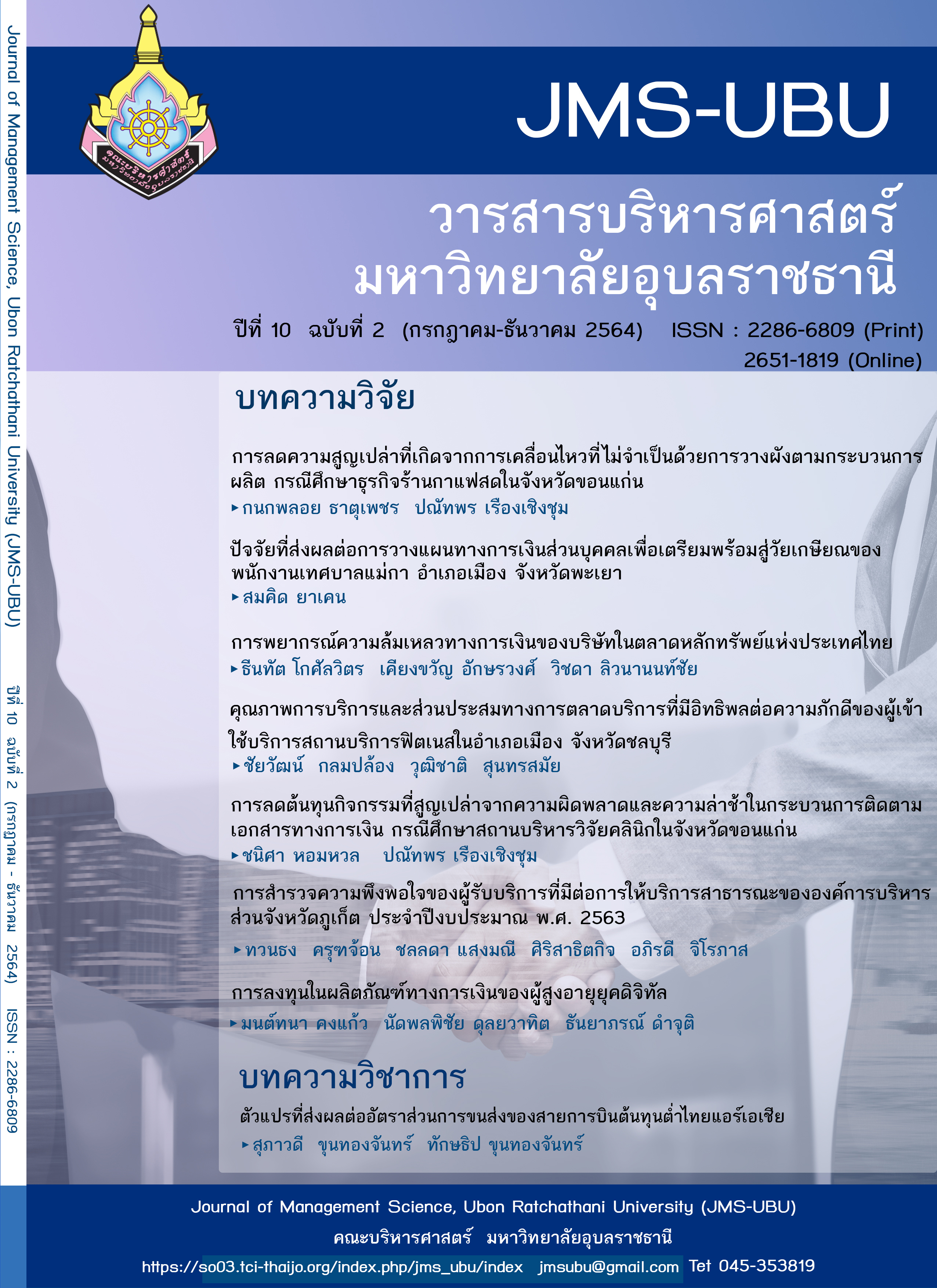การพยากรณ์ความล้มเหลวทางการเงินของบริษัทในตลาดหลักทรัพย์ แห่งประเทศไทย
Main Article Content
บทคัดย่อ
งานวิจัยนี้มีวัตถุประสงค์เพื่อศึกษาความแม่นยำของแบบจำลอง Altman’s EM-Score Model ในการพยากรณ์ความล้มเหลวทางการเงินของบริษัทจดทะเบียนในตลาดหลักทรัพย์แห่งประเทศไทย และพัฒนาแบบจำลองใหม่เพื่อเพิ่มความสามารถในการพยากรณ์ ในงานวิจัยนี้นิยามความล้มเหลวทางการเงินคือการที่หลักทรัพย์ถูกขึ้นเครื่องหมาย SP หรือ NC ข้อมูลที่ใช้คือ ข้อมูลจากงบการเงินล่วงหน้า 1 ปี ของบริษัทจดทะเบียน ในปี 2542 – 2560 จำนวน 188 บริษัท เครื่องมือที่ใช้ในการวิจัย คือ การวิเคราะห์ความถดถอยโลจิสติกและตารางไขว้เพื่อประเมินประสิทธิภาพการพยากรณ์ ผลการศึกษาพบว่า (1) ในแบบจำลอง Altman’s EM Score Model มีการพยากรณ์ถูกต้องคิดเป็นร้อยละ 71.8 และการพยากรณ์ไม่ถูกต้องประเภท Type I Error และประเภท Type II Error คิดเป็นร้อยละ 50.0 และร้อยละ 6.4 ตาหมลำดับ (2) หากเพิ่มตัวแปรอัตราส่วนหนี้สินต่อสินทรัพย์รวมและอัตราส่วนกระแสเงินสดจากการดำเนินงานต่อหนี้สินรวมในแบบจำลอง Altman’s EM-Score Model จะทำให้ประสิทธิภาพการพยากรณ์ดีขึ้น โดยสามารถพยากรณ์ถูกต้องร้อยละ 83.0 และการพยากรณ์ไม่ถูกต้องเป็น Type I Error และ Type II Error เท่ากับร้อยละ 22.3 และ ร้อยละ 11.7 ตามลำดับ
Downloads
Article Details
บทความที่ตีพิมพ์ในวารสารบริหารศาสตร์ มหาวิทยาลัยอุบลราชธานี เป็นลิขสิทธิ์ของวารสาร โดยเนื้อหาและความคิดเห็นในบทความเป็นความรับผิดชอบของผู้เขียนแต่ละท่าน ไม่เกี่ยวข้องกับคณะบริหารศาสตร์ มหาวิทยาลัยอุบลราชธานีแต่อย่างใด และหากมีข้อผิดพลาดประการใด ผู้เขียนจะเป็นผู้รับผิดชอบต่อบทความของตนเองแต่เพียงผู้เดียว
เอกสารอ้างอิง
ชยาภรณ์ มงคลเสรีชัย. (2560). การวิเคราะห์ความล้มเหลวทางการเงินของบริษัทที่จดทะเบียนในตลาดหลักทรัพย์แห่งประเทศไทย กรณีศึกษากลุ่มอุตสาหกรรมยานยนต์. วารสาร มจร สังคมศาสตร์ปริทรรศน์, 6(2), 55-67.
ตลาดหลักทรัพย์แห่งประเทศไทย. (2563). สรุปสถิติสำคัญของตลาดหลักทรัพย์. สืบค้นเมื่อ 5 มิถุนายน 2563 สืบค้นจาก https://www.set.or.th/th/market/market_statistics.html
นฤมล ใจแสน. (2559). การพยากรณ์ความล้มเหลวทางการเงินของบริษัทที่จดทะเบียนในตลาดหลักทรัพย์ เอ็ม.เอ.ไอ. (การค้นคว้าอิสระปริญญามหาบัณฑิต). มหาวิทยาลัยธรรมศาสตร์, คณะพาณิชยศาสตร์และการบัญชี.
ปานรดา พิลาศรี และมนวิกา ผดุงสิทธิ์. (2554). แบบจำลองการพยากรณ์ความล้มเหลวทางการเงิน วิธีวิเคราะห์จำแนกประเภท. วารสารวิชาชีพบัญชี, 7(18), 26-42.
พรปวีณ์ วงศ์พร้อมสุข. (2559). การพยากรณ์ความล้มเหลวทางการเงินของบริษัทพัฒนาอสังหาริมทรัพย์ที่จดทะเบียนในตลาดหลักทรัพย์แห่งประเทศไทย. (การค้นคว้าอิสระปริญญามหาบัณฑิต). มหาวิทยาลัยธรรมศาสตร์, คณะพาณิชยศาสตร์และการบัญชี.
อรรถพงศ์ พีระเชื้อ. (2561). ตัวแบบพยากรณ์บริษัทจดทะเบียนที่อาจถูกเพิกถอนจากตลาดหลักทรัพย์แห่งประเทศไทย. WMS Journal of Management Walailak University, 7(2), 8 – 22.
Altman, E. I. (1968). Financial ratios, discriminant analysis and the prediction of corporate bankruptcy. The Journal of Finance, 23(4), 589–609.
Altman, E. I., Hartzell, J., & Peck, M. (1998). Emerging market corporate bonds : A scoring system. In R. M. Levich (Ed.), Proceedings of a Conference held at the Stern School of Business (pp.391-400). NewYork: New York UniversityJune.
Beaver, W. H. (1966). Financial ratios as predictors of failure. Journal of Accounting Research, 4 (1), 71–111.
Cultrera, L. & Brédart, X. (2016). Bankruptcy prediction: The case of Belgian SMEs. Review of Accounting and Finance, 15(1), 101-119.
Huang, J., Wang, H., & Kochenberger, G. (2017). Distressed Chinese firm prediction with discretized data. Management Decision, 55(5), 786-807.
Jooste, L. (2007). An evaluation of the usefulness of cash flow ratios to predict financial distress. Acta Commercii, 7(1), 1-13.
Purves, N. & Niblock, S. J. (2018). Predictors of corporate survival in the US and Australia: An exploratory case study. Journal of Strategy and Management, 11(3), 351-370.
Salehi, M., & Pour, M. D. (2016). Bankruptcy prediction of listed companies on the Tehran Stock Exchange. International Journal of Law and Management, 58(5), 545-561.
Sandin, A. R., & Porporato, M. (2007). Corporate bankruptcy prediction models applied to emerging economies Evidence from Argentina in the years 1991-1998. International Journal of Commerce and Management, 17(4), 295-311.
Sasivimol Meeampol, Polwat Lerskullawat, Ausa Wongsorntham, Phanthipa Srinammuang, Vimol Rodpetch & Rungsimaporn Noonoi (2014). Applying emerging market z-score model to predict bankruptcy: A case study of listed companies in the Stock Exchange of Thailand (Set). Human Capital without Borders: Knowledge and Learning for Quality of Life; Proceedings of the Management, Knowledge and Learning International Conference 2014 (pp. 1227-1237). ToKnowPress. Retrieved from
http://www.toknowpress.net/ISBN/978-961-6914-09-3/papers/ML14-724.pdf

